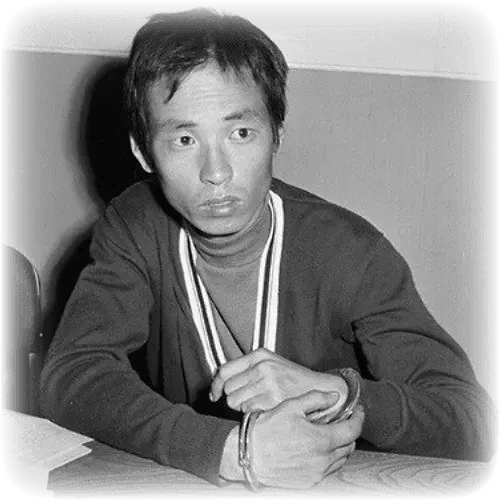
Kim Dae-Doo
In just 55 days, he slaughters 17 people across the country. His execution ends the spree, but not the questions over how he slipped past police.
Kim Dae-doo, South Korea's first male serial killer, will go down in history not just for the sheer horror of his crimes, but for the chilling speed and brutality with which he executed his killing spree. Born on November 17, 1949, in the rural town of Yeongam County, South Jeolla, Kim’s life seemed destined to be ordinary—yet it was marked by poverty, family pressures, and a spiraling descent into violence.
The eldest son in a large family of seven children, Kim's early life was shaped by high expectations. His parents dreamed of sending him to a prestigious middle school in a large city, hoping he would break free from the grinding poverty of their rural existence. However, Kim failed his exams and struggled academically, fostering a deep inferiority complex. His inability to meet his parents’ expectations left him feeling worthless, and as his teenage years unfolded, his dissatisfaction with society grew. His failure to adapt to a life of respectability led him to petty crime. At just 17, Kim was arrested for assault and tampering with evidence—a sign of things to come.
Despite his troubled start, Kim briefly attempted to turn his life around. After his release from prison, he worked a series of menial jobs in factory settings, trying to make an honest living. However, his reputation as an ex-convict followed him, leaving him embittered and resentful. The closed doors of society only pushed Kim further into despair. He became increasingly alienated, a man set adrift in a world that had never embraced him. The yearning for revenge, for control, started to consume him.
In 1975, just after being released from prison for his earlier offenses, Kim embarked on a horrific rampage that would claim the lives of 17 people over the course of 55 days. His first murder came on August 13, 1975, when he attempted to rob the home of an elderly couple in Gwangju. During the robbery, he killed the man and severely injured the woman. After the murder, Kim fled to Suncheon, where he met an accomplice—another ex-convict, Kim Hoe-woon. Together, they would go on to commit another series of gruesome killings.
Their next target was a family operating a small shop in Mongtan, Muan County. The pair murdered the elderly couple and their 7-year-old grandson before fleeing the scene. Afterward, they traveled to Seoul, where they planned to rob a house filled with cash. But Kim’s partner in crime, Hoe-woon, grew wary of the killings and ultimately parted ways with him. From then on, Kim was alone—an increasingly dangerous individual, unburdened by any moral restraint.
On September 7, Kim killed a 60-year-old man in Seoul’s Jungnang District, breaking into his home under the cover of night. Just weeks later, he traveled to Pyeongtaek, a rural area near Seoul, where he encountered an elderly woman and her three grandchildren. In a brutal attack, Kim used a meat cleaver to hack at the woman and two young boys (aged 5 and 7), mutilating their faces beyond recognition. The attack was so violent that the cleaver's handle broke in the process. Kim then dragged the 11-year-old granddaughter outside the house, attempting to rape her. When he failed, he tied a cloth around her face, suffocating the child to death.
The series of killings continued without pause. On September 27, Kim murdered a young couple and their 3-year-old child in Guri, leaving two others severely wounded. Three days later, he broke into a home in Gunpo, where he raped and killed the mother and then beat her 3-month-old baby to death. The murders were becoming more horrific, the brutality escalating as Kim sought to satisfy his twisted desire for power and control.
On October 2, Kim attacked a young couple in Suwon, killing them both. The next day, he attempted to murder a caddy at a golf course in Suwon, but the victim survived. Kim’s desperation and recklessness began to show—he was becoming more brazen and careless in his attacks.
On October 7, Kim approached a young man he had met in Dobong District, attempting to recruit him as an accomplice. However, the young man tried to steal Kim's belongings and run. Kim chased him down and killed him, taking the victim's jeans in the process. In a final stroke of madness, Kim went to a laundromat near Cheongnyangni Station, where the bloody jeans were cleaned. When the laundromat owner, Ha Geun-bae, asked why there was so much blood on them, Kim claimed it was from a nosebleed after a fight. Ha, unconvinced, contacted the authorities.
Kim was soon arrested, and despite his initial denials, he eventually confessed to the murders. His cold, emotionless demeanor during his interrogation and the on-site inspections shocked investigators. Kim Dae-doo was a man without remorse, his self-loathing transformed into a rage that spilled out in violence.
Cultural Context
South Korea’s rapidly modernizing society in the 1970s was unfamiliar with such acts of brutality. Kim's vicious attacked shocked the nation, and his case became a watershed moment in the country's criminal history, revealing the deep psychological scars of a man cast aside by society.
The arrest of Kim Dae-doo on October 8, 1975, would prove to be the first step in unraveling one of South Korea’s most chilling murder frenzies. Yet, the investigation into his horrific crimes would be anything but straightforward. Kim’s arrogance, his cold demeanor, and the complexity of his killing frenzy created a storm of confusion for the police. His confession was just the beginning of a dark journey into his mind and his motivations.
After his capture, Kim initially denied any involvement in the murders. He maintained the bizarre explanation that the bloodstains on the jeans he had taken from his victim’s body were the result of a nosebleed after a fight with a friend. This claim, however, was too weak to stand up to the growing suspicion around him. Ha Geun-bae, the laundromat owner who had noticed the large amount of blood, reported Kim to the authorities, prompting a deeper investigation into the man.
At the police station, Kim’s story shifted, as his initial tale of a simple altercation was exposed as a lie. When investigators began to dig further, they realized his unbelievable arrogance. Kim seemed to lack any true remorse. Even as the police pushed him harder, Kim's attitude seemed dismissive, as though he viewed his crimes as something inconsequential. A chilling moment occurred when Kim was taken for an on-site inspection to show how he had committed the murders. It was rumored that he acted arrogantly, chewing gum and laughing while recounting the details of his killings.
As Kim was pressured into confessing, the full extent of his crimes became clear. It started with a burglarized home in Gwangju, where Kim had killed the elderly man and left his wife seriously injured. What followed was a trail of gruesome murders that lasted until early October. His murderous journey spread across multiple regions, ranging from Gyeonggi-do to Seoul and Muan County.
Did You Know?
Kim Dae-doo's killing spree was exceptionally fast, lasting only 55 days, but the brutality was unmatched. His choice of isolated homes as targets reflected his preference for vulnerable victims—often robbing homes with little money or valuables.
Kim's methodology revealed much about his character. He often targeted isolated and impoverished homes, which were less likely to attract attention or resources. What was even more disturbing was his decision to kill indiscriminately—young and old, men and women, families and individuals alike. Kim’s brutality was unrestrained, and the gruesome details of his killings left investigators speechless. One particularly haunting attack on September 25, 1975, in Pyeongtaek, involved an elderly woman and her three grandchildren. Kim used a meat cleaver, hacking into their faces so violently that their features were unrecognizable, the cleaver's handle breaking in the process.
But the most harrowing moment of that particular attack was when Kim attempted to rape the 11-year-old granddaughter. Failing in his attempt, Kim went on to tie her to a tree and, in a brutal act of suffocation, left her to die. This was just one example of the unfathomable cruelty that defined Kim’s brutal attacks. It was not just murder—it was an act of calculated violence meant to break the spirit of his victims.
The investigation also revealed disturbing details about Kim's interactions with accomplices. Initially, Kim had partnered with an ex-convict named Kim Hoe-woon, whom he met on a train. They killed together on multiple occasions, but their partnership was short-lived. Kim Hoe-woon eventually left, unwilling to continue. Kim, however, seemed unfazed by his partner’s departure. He carried on alone, targeting victims with a chilling indifference that defined the remainder of his shocking attacks.
Investigators soon began to uncover the chillingly random nature of Kim’s murders. Unlike more methodical serial killers, Kim did not focus on any particular type of victim or method of killing. His victims ranged from elderly couples to young children, and he used a wide array of weapons—from a meat cleaver to blunt objects. This chaotic approach suggested a man whose motives were far less about robbery or gain and far more about satisfying a deep psychological urge.
Investigator Profile
Detective Hong Hwa-seop was among the team that helped bring Kim to justice. His tenacity during the investigation led to Kim's confession, even when it seemed Kim’s arrogance would prevent him from ever fully cooperating. Detective Hong's insistence on questioning Kim about the bloodstains in his jeans, despite Kim's dismissive responses, ultimately led to his arrest and conviction.
The rest of this story can be found in Volume #3 of Macabre True Crimes and Mysteries

